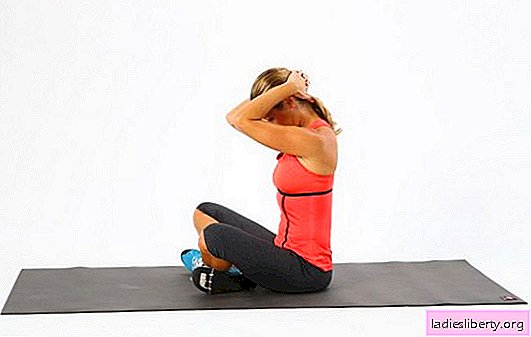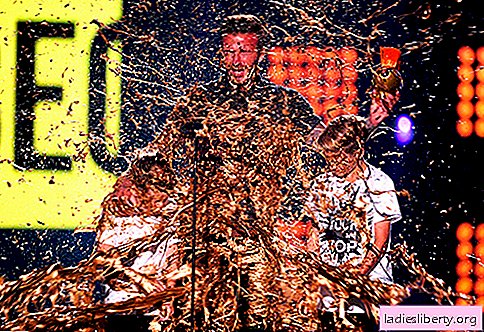
The human spine is a complex and well-functioning mechanism that allows you to walk straight. A minor factor is enough for this mechanism to fail. According to medical statistics, every fourth person in the world suffers from problems with the spinal column, the "lion's share" of all pathologies is cervical and lumbar osteochondrosis.
The question is, is there an alternative to medication for neck problems? The answer is twofold. You can’t do without drugs, but the special gymnastics of Dr. Bubnovsky will be a good help in the fight against ailments. But what is it?
Why gymnastics is effective and how it works
Performing the exercises of the complexes described below, a person solves several tasks at once:
• Strengthens the muscles of the neck. With osteochondrosis, a weakening of the muscle corset occurs. In the future, this leads to the destruction of the intervertebral discs and the development of hernias.
• Improves nutrition of vertebral structures. Lack of blood supply, this is one of the main causes of all troubles with the neck.
• Helps normalize muscle tone. Not all muscles require strengthening. Some of them are in constant hypertonicity. This is a direct path to the violation of cerebral circulation, and there is not far from a stroke. Gymnastics allows you to relax these "petrified" muscles.
It is recommended to carry out complexes at home, or in small groups of 3-5 people. Age does not matter: physical activity of this kind is equally useful for young people and elderly patients.
The simplest exercises of gymnastics for the Bubnovsky neck
The complex of exercises №1
Exercises of this complex are not suitable for everyone. Despite the fact that they belong to the category of "sparing", during the period of exacerbation of diseases of the spine, these exercises are not recommended. However, there is no talk of an absolute prohibition; it is recommended to consult a doctor.
1) Sit in a high chair. Alternatively, standing is acceptable. Relax completely, the head due to relaxation should hang slightly on the chest. Start making light oscillatory movements of the head (nodding). Nods should be weak and barely noticeable.
2) Sit upright. Relax as much as possible. Relaxation extends, including to the shoulders and the entire collar region as a whole. Put one palm on the forehead, slightly press on the head. The neck in this exercise serves as a "counterweight". The head should make a movement, as if wishing to push the hand away. Such resistance has a good effect on the muscles, toning them and setting them in motion.
3) Take a position identical to that practiced in exercise "1". Make light head sway from side to side. The strength of the movements should be at a minimum, otherwise the risk of injuries or pinching of the nerve roots is high. Perform for two minutes.
4) Perform exercise "2", moving the hand from the forehead to the temporal region. Now it is necessary to make head movements in the direction of the hand, as if wanting to “move” the limb. Perform 7-12 times. Each such "time" of duration should not exceed 2-3 seconds. An increase in time will not affect efficiency in any way.
5) Take a vertical position. Straighten your arms as much as possible and spread to the side. The pose should resemble the letter "T". Now you need to make 10-12 circular movements of the hands clockwise and 10-12 movements counterclockwise. Important! The movement comes from the shoulder, elbows and hands remain motionless.
6) Take a sitting pose. With a sharp movement, raise your shoulders, trying to reach your ears. Keep position for a couple of seconds. Also sharply lower your shoulders. The neck should remain motionless all this time.
7) Massage the neck. A light massage should last at least 1-3 minutes. Movements are circular.
8) Sit upright. Lower your shoulders as much as possible while trying to stretch your neck. The exercise is performed slowly so that there are no injuries. Duration - 8-10 times.
The complex of exercises №2
This complex is suitable for all patients.
1) Take a vertical position. Relax your whole body. Slowly lower the chin to the chest. It is not necessary to press it. Then sharply raise your head and return to the original position. Exercise allows you to alternate tension and muscle relaxation, due to which there is a normalization of their tone.
2) Get up. Relax all your muscles. According to the account, "one" to turn his head to the right as much as possible. Without haste, return to the starting position. Then also turn left. Haste in this exercise is dangerous, all turns should be smooth and natural.
3) Stand up exactly as in the previous exercises. Tilt your head back slowly, stay in that position for a few seconds.
The complex of exercises №3
The third set of exercises is also ideal for patients in various conditions: both in remission and during exacerbation.
1) Perform exercises "1", "3" complex number 1.
2) Get up straight. Take a few deep breaths. Hands to form the letter "T". Now you need to bend over and perform the exercise "mill".
3) Take a vertical position. Relax your whole body. Hands should hang freely on the sides of the body. At the expense of "one" raise the left shoulder, trying to reach the ear. At the expense of "two" lower the shoulder. On account of "one" repeat the same with the other shoulder.
4) Re-adopt a position identical to the past. Hands freely straightened "at the seams". With fully relaxed limbs, make 10 circular movements of the shoulders in a clockwise direction, then 10 in a counterclockwise direction.
5) Get in a comfortable position. The body is relaxed. Legs at shoulder level. On account of "one" raise his right hand above his head. Lower. Do the same with the other limb.
The initial poses and necessary movements are displayed in the photo of gymnastics for Bubnovsky’s neck.

The three complexes presented are quite sufficient if we are talking about problems with the neck in the initial stage. If the process is “running,” more complete and complex exercises are required. Fortunately, the description of gymnastics for Bubnovsky's neck includes other, more complex and effective complexes.
The most effective gymnastics exercises for Bubnovsky’s neck
The effectiveness of the following complexes has been proven, but they are intended only for patients in remission. An acute condition is an absolute contraindication for performing exercises. This is dangerous and fraught with deterioration.
The complex of exercises №1
1) Sit on a chair. Press your back, the position should be stable. Tilt your head slowly and lay it on your chest. Now you need to start making circular rotational movements. This should be done smoothly and carefully, observing your own feelings. Improper execution technology is fraught with dislocations.
2) Take a horizontal position. It’s better to lie down on something hard (ideally on the floor). Start turning your head to the right, then to the left, as if wanting to see what is happening on either side.
3) Sit down, take a stable position. On account of the "one" exhale. During exhalation, lower your head to your chest and press your chin tightly. Then take a breath and return to the starting position.
4) Lie on your stomach. Hands "at the seams", relax as much as possible. On account of the "time" turn your head and press your ear to the floor. Lock in position for a few seconds. Then do the same, but turning already in the other direction.
5) The position is identical. Place your hands under the chin. According to the account, "one" to rise and bend the back, while straightening the neck as much as the state and its own anatomy of the spine. On account of the "two" return to their original position.
6) Get up or sit down. Relax your neck so that your head hangs a little. The chin should not touch the chest. Start making horizontal head movements, imitating a no gesture.
Complex exercise number 2
1) Take a vertical position. Hands clenched into fists, as if holding invisible dumbbells, spread apart. The inner sides of the forearms should be pointing up. On account of "one" hands are bent, on account of "two" it is necessary to return them to their original position.
2) Stand up again. Put the brushes on the shoulders, make light circular movements. The amplitude is minimal. The exercise is performed 10 times clockwise and 10 times counterclockwise.
3) Take a vertical position. Hands to form a castle, lay the limbs behind the back of the head. For the same purpose, a towel is suitable. The essence of the exercise is the "confrontation" of the neck and arms. Such physical activity has a beneficial effect on muscle condition.
4) Repeat the same thing with your hands on your forehead.
5) Get up straight. Relax. Train, moving your shoulders together, then part them and return to the starting position. Repeat 7 times.
6) With your right hand, touch the left ear, grab your head and pull it in the opposite direction. Haste excluded.
7) Repeat exercise "5", only this time to part the shoulders, straining the muscles of the back.
8) Take a horizontal position. On the account of "one" raise your head above the floor, on the account of "two" to return to the original position.
The complex of exercises №3
This complex is an optimized version that is suitable, including for people with exacerbation of diseases of the spinal column and surrounding structures.
1) Take a sitting pose. Relax your neck. Lean your head to the left, linger in this position for half a minute. Then, with the same smooth movement, lay your head to the right. At the "exit" there should be a pendulum-like movement. Perform the exercise 5-10 times.
2) Relax. Sit down. Lower the head to the chest, leave in this position for half a minute. Then raise the elongated neck. Repeat 7 times.
3) Sit down, take a comfortable pose. According to the “one” account, turn your head to the left “to the stop”, as far as there are enough health opportunities. On account of the "two" slightly raise his head and look up. On account of the "three" to lower the head and return the neck to its original position.
4) Take a standing or sitting position, grasp the opposite shoulder with your hand. Stay in that position for half a minute. To do the same with the other hand.
5) The principle of the exercise is similar to the previous one. The difference is that your arms should be raised above your head.
6) Perform exercise "8" gentle complex number 1. Quantity - 15 times.
7) Take a vertical position. On account of the "one" to crank your neck as much as possible. On account of the "two" put your ear on your shoulder. Movement should begin from the lower parts of the neck. On account of the "three" to return to their original position.
In the complex of these exercises is enough to keep the spine in good shape.
For familiarization, a video of gymnastics for the Bubnovsky neck is also recommended:
How to do gymnastics for the Bubnovsky neck
There are several rules for doing exercises:
1) Exercises are fully recommended to be fully performed only during the period of remission of the underlying disease.
2) It is necessary to monitor breathing. The increase in pace suggests that the number of times and / or approaches should be reduced.
3) You should not engage in a forced pace. It is recommended to start the exercise 3-5 times.
4) To obtain a therapeutic effect, gymnastics is recommended to do 2-4 times a day.
5) Pain should be excluded.
Observing these rules, a person protects himself from undesirable consequences and guarantees the effectiveness of gymnastics.











